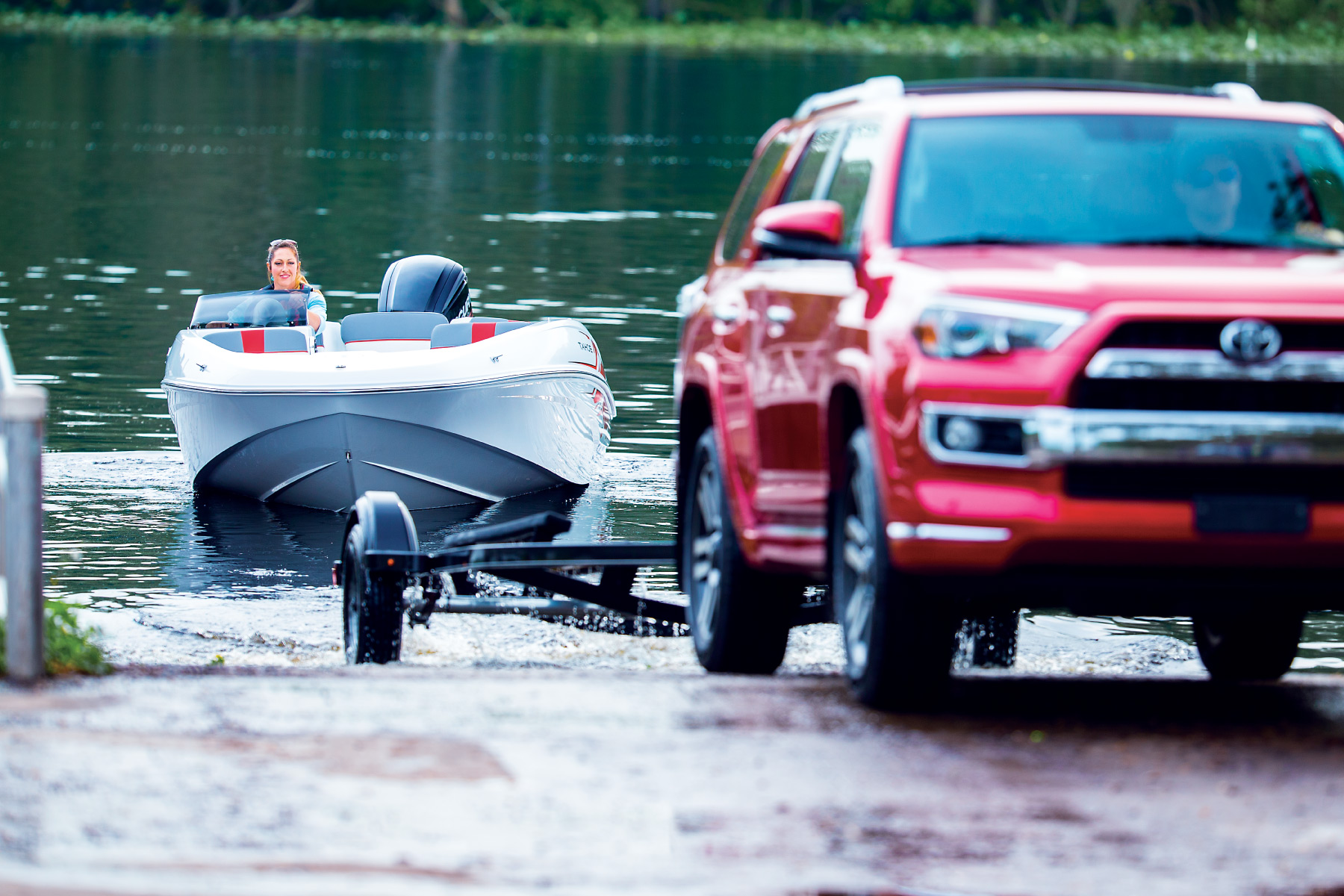Once upon a time, choosing a tow vehicle to pull a boat began and ended with one feature—fastening a hitch and tow ball to the rear fender. Today, boaters can benefit from vehicles that are geared specifically for towing boats.
Factory-installed towing packages are loaded with features that enhance towing performance and handling, while improving safety and fuel economy. Computer-monitored and controlled systems keep the engine, transmission and even brakes working in sync to provide a better towing experience. With some trucks, you don’t even know the boat is hooked up without looking in the side view mirrors.
With all that in mind, it makes sense to know what options are best for towing your boat. Use these helpful tips when matching your vehicle with the boat.
Before you buy, the first step should be calculating the cumulative weight of the boat and engine, the trailer and a rough calculation of the gear you will pack for your adventures. The good news is boat manufacturers do the math for you with exception of the gear you will pack. Examples are the White River Marine Group brands. On the brand websites, you will find Specs and Layout pages with a listing for Average Package Weight. You can also have your rig weighed on the scales at a truck stop. Before you go, load up as you would for a day on the lake. Unhook the trailer so the tongue jack rests on the scale. This will also give you the tongue weight.
If you want to tow a package weighing around 5,000 pounds—which is about average package weight for a full-size bass boat, bowrider or pontoon—you will be better off with an SUV or full-size pickup. The latter class of vehicle also offers the most optional towing packages. Compare the towed weight of your rig with the vehicle tow rating. You can find it on the brand website or at the dealership. Above all else, don’t skimp. If your rig weighs 6,000 pounds, select a tow vehicle with a towing rating of 7,500 to 8,000 pounds to be safe.
Horsepower and torque are the most important criterion in determining towing capacity, so don’t be conservative. More power is better if hills and mountains are along the route, or if you need a horsepower boost for the passing lane of the interstate. You have two power choices with gasoline or diesel. Gas engines remain the most popular, although diesel is gaining popularity, especially when towing loads of more than 8,000 pounds. What is great about gasoline options are the engines are technically advanced to tow heavier loads than ever before. The Toyota Tundra can tow up to 10,000 pounds, while the Ford F-150 offers six engine choices that include its EcoBoost V6 that is a top performer when compared to other V6 engines.
Today’s advanced transmissions work in tandem with the techy engines to maximize the capabilities of the vehicle. The number of available gears has steadily increased from six to 10 to help keep the engine revving in its power band. Choose the vehicle with the greatest number of gears. For example, the Ford F-150 is available with 10-speed transmissions in its 2.7L EcoBoost and other engines.
Some transmissions also help control downhill speed when towing. Wheel brakes can quickly overheat and become ineffective. In these situations, manually downshifting to lower transmission gears takes some of the burden off the brakes. However, some newer transmissions automatically downshift at the touch of the brake pedal. Some require that you switch on the “tow/haul” mode to activate this feature. Tow packages almost always include heavy-duty cooling systems, not only for the engine coolant but for the engine oil and transmission fluid as well. The rigors of towing—especially uphill—can generate substantial engine and transmission heat, and heavy-duty cooling systems help maintain proper operating temperatures and prevent damage. Some tow packages also include special gauges to monitor drivetrain fluids.
Here is the fun part. You have myriad choices when choosing an optional towing package. Trailer Sway Control, Hill Start Assist, Trailer Brake Controller, 360-Degree Camera System, Dynamic Hitch Assist and Pro Trailer Backup Assist. Those are the high-tech features available with the Ford F-150. The Toyota Tundra’s heavy-duty TripleTech frame features an integrated tow hitch receiver and trailer hitch. As you shop, you will discover the choices that line up best with your needs. If you want to keep it basic, no problem. High tech? It’s there, too.
Which is best? You obviously should not need traction for pulling your boat in the snow. Where you might need traction is at the launch ramp. If you use ramps at lakes that are subject to seasonal drawdowns or extreme tides, then four-wheel drive might be helpful. If you plan on using unpaved ramps, then four-wheel drive is a must on muddy or sandy inclines. Otherwise, two-wheel drive can save you money on the purchase price.
You will likely encounter these terms when comparing specs about towing weight. Here is a glossary to help guide you through the choices.
GCVW
Gross Combined Vehicle Weight (GCVW) is the total combined weight of a fully loaded vehicle, including passengers, payload and everything in tow.
GVW
Gross Vehicle Weight (GVW) is the total weight of a fully loaded vehicle, including passengers and payload—but excluding all towing.
GTW
Gross Trailer Weight (GTW) is the total weight of the trailer plus all the cargo in it.
Curb Weight
The weight of a vehicle without any passengers or cargo, but including all necessary fuel, fluids and standard equipment.
Axle Ratio
The ratio between the revolutions per minute of the driveshaft and the rear axle. In general, a higher number offers more towing power; a lower number offers better engine efficiency.
Trailer Tongue Weight
The downward force exerted on the hitch ball by the trailer coupler. In most cases, it should fall between 10 to 25 percent of GTW. Tip: Trailer tongue weight must be accounted for in total payload.


